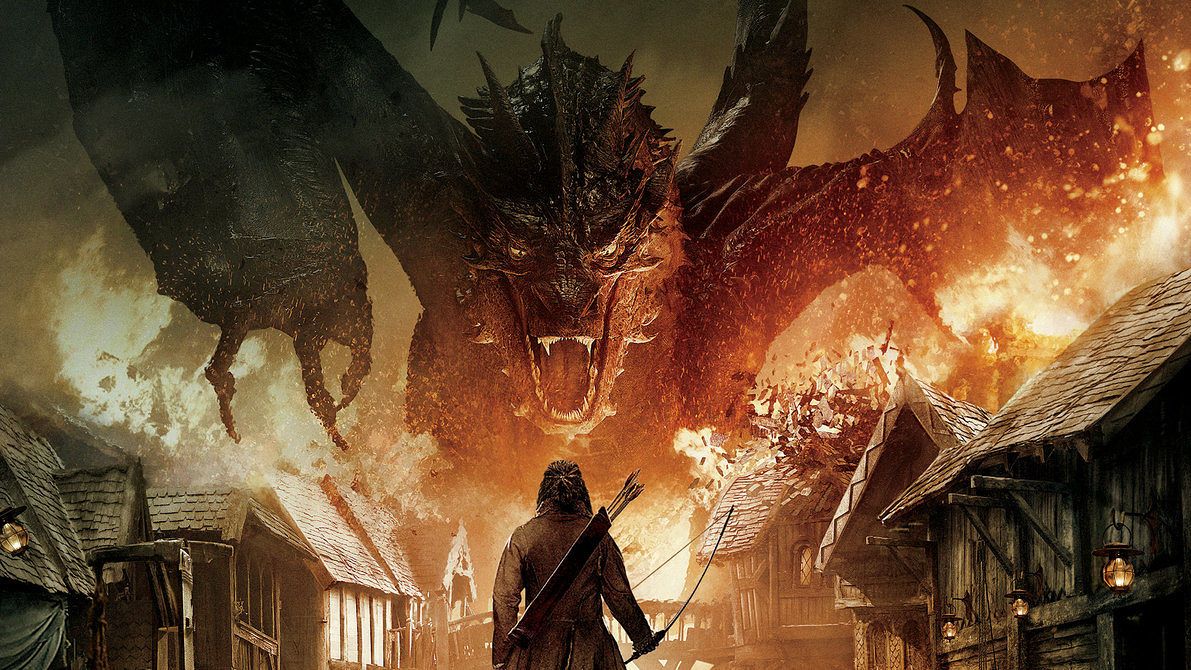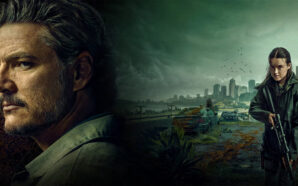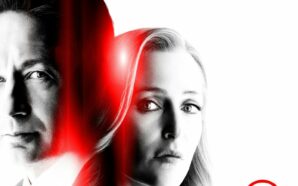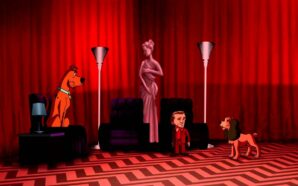For the past couple of weeks, I’ve been revisiting Peter Jackson’s The Hobbit trilogy for the first time in years and, so far, it’s been a pleasant surprise. I remembered the films as having good moments but ultimately as failures of the Middle Earth franchise. But upon rewatching both An Unexpected Journey and The Desolation of Smaug, I discovered that the films were in fact quite fun adventures for the most part. There are significant flaws and a noticeable, but gradual, decline in quality as they progress, but the films are entertaining when they sneak out of the shadow of the far superior Lord of the Rings trilogy. The Battle of the Five Armies however refuses to do such a thing and foolishly embraces the prequel roots of the story fully, giving us a final instalment that makes the trilogy feel like nothing but superfluous setup. After the joyous surprise of the first two films, The Battle of the Five Armies is the Hobbit adaptation I remembered. A bloated and unnecessarily dark tale that, despite containing a few good scenes, ranks as the worst instalment of the Middle Earth saga.
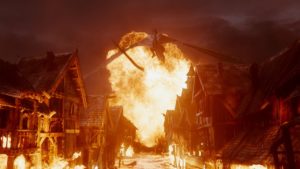 Battle picks up immediately after the end of the previous film, with Smaug heading to Lake-town to burn the wooden settlement to cinder. The film certainly doesn’t have the early pacing problems that plagued Desolation, and we immediately witness the destructive force of the dragon that Bilbo and the Dwarves awakened from its slumber. Revisiting the film now that we live in a post-Game of Thrones world, it’s impossible to not draw comparisons to the sheer annihilation we saw Drogon reign down on King’s Landing in the eighth season of the show. Smaug’s attack therefore feels a little underwhelming when compared to the hour-long display of fiery chaos broadcast on the show, but it is still an entertaining sequence for the most part. The big creative decision that sets them apart is that Game of Thrones portrays a very human view of the horror, sticking to ground level and never cutting to Drogon and Daenerys’ point of view, whereas Jackson is more interested in Smaug’s bombing runs and gives us huge cinematic shots from the dragon’s point of view.
Battle picks up immediately after the end of the previous film, with Smaug heading to Lake-town to burn the wooden settlement to cinder. The film certainly doesn’t have the early pacing problems that plagued Desolation, and we immediately witness the destructive force of the dragon that Bilbo and the Dwarves awakened from its slumber. Revisiting the film now that we live in a post-Game of Thrones world, it’s impossible to not draw comparisons to the sheer annihilation we saw Drogon reign down on King’s Landing in the eighth season of the show. Smaug’s attack therefore feels a little underwhelming when compared to the hour-long display of fiery chaos broadcast on the show, but it is still an entertaining sequence for the most part. The big creative decision that sets them apart is that Game of Thrones portrays a very human view of the horror, sticking to ground level and never cutting to Drogon and Daenerys’ point of view, whereas Jackson is more interested in Smaug’s bombing runs and gives us huge cinematic shots from the dragon’s point of view.
While this directional choice does give us multiple cool shots of the massacre, it sacrifices character drama and emotion. We don’t really care for the people of Lake-town who are being decimated with every blast of dragon-fire. The only reason to keep some of the Dwarves in Lake-town while the rest of the company travelled to the Lonely Mountain is to put some characters we know in peril, but they don’t do anything during the attack but slowly float away on a boat. Bard is the primary point of view character and his feeble defense of the town soon gets the attention of Smaug. The two face off and the sequence gets much more interesting when it narrows the focus to this personal battle, and finally, with the arrival of Bard’s son carrying the Black Arrow, we get some emotional stakes. While it’s a little contrived and over the top, I do like the moment of Bard using his son’s shoulder to rest the arrow on as he takes the fateful shot; a miss meaning certain death for both of them but a hit ensuring their survival, as well as saving the remaining residents of Lake-town.
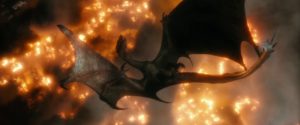 The arrow strikes true and Smaug is killed a mere 11-minutes into the 164-minute runtime. If you don’t know the story of The Hobbit before watching the films then this is no doubt a major twist. The primary antagonist of the trilogy is dead before the title card appears onscreen. It had to happen this way considering the bizarre structure of the trilogy, birthed by splitting a simple terse novel into three epic films, but it’s hard not to be feel slightly underwhelmed. After the credits roll on The Battle of the Five Armies, the attack on Lake-town feels like it’s from a completely different film. While the timing and impact of Smaug’s death is maybe a little disappointing, his actual demise is very well executed. Seeing him rise into the air, squirming in pain and shouting in a way only Benedict Cumberbatch can, before the fire goes out from behind his eyes, as well as in his belly, is a great moment.
The arrow strikes true and Smaug is killed a mere 11-minutes into the 164-minute runtime. If you don’t know the story of The Hobbit before watching the films then this is no doubt a major twist. The primary antagonist of the trilogy is dead before the title card appears onscreen. It had to happen this way considering the bizarre structure of the trilogy, birthed by splitting a simple terse novel into three epic films, but it’s hard not to be feel slightly underwhelmed. After the credits roll on The Battle of the Five Armies, the attack on Lake-town feels like it’s from a completely different film. While the timing and impact of Smaug’s death is maybe a little disappointing, his actual demise is very well executed. Seeing him rise into the air, squirming in pain and shouting in a way only Benedict Cumberbatch can, before the fire goes out from behind his eyes, as well as in his belly, is a great moment.
But Smaug’s promise of fire and death wasn’t the only cliffhanger remaining from The Desolation of Smaug. Gandalf is a prisoner of Sauron at the ruins of Dol Guldor and the evil lord is but seconds away from killing the wizard until the White Council arrive to save him. Seeing Galadriel as a pure white figure walking through the gloomy ruins is a fantastic image, and the Council coming together is a cool moment for any Lord of the Rings fan. Elrond, Saruman, Radagast and Galadriel unleash their full powers, and the Council uniting feels more like something from a superhero film rather than high fantasy, with moments ranging from very cool to cringey, like Christopher Lee’s body double fighting CGI ghosts. The scene explicitly sets up The Lord of the Rings and the whole Dol Guldor subplot in all three films has felt far too disconnected from the core storyline of The Hobbit. While I do enjoy seeing Saruman’s reaction to Sauron’s return, knowing what is to come, The Battle of the Five Armies puts too much focus on simply being a precursor to a later story rather than telling its own.
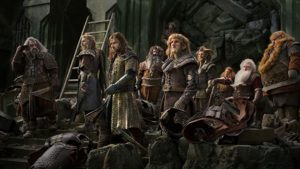 Success is short lived at Erebor. While Smaug is dead and the Kingdom belongs to the Dwarves once more, others now look to the mountain for its immense wealth and tactical position. The following hour of the film sees an awful lot of political manoeuvring and characters quickly traveling to prepare for the coming battle. The Dwarves, now driven by greed, seek to defend their position; Thranduil’s Elves arrive at Dale with their cold blue contact-lensed eyes focused on Erebor’s treasure; and Bard becomes the noble leader of Lake-town’s survivors, wishing to take shelter within the mountain. After a fairly lacklustre introduction to Bard in the previous film, I grew to like the character much more in the trilogy’s final instalment and he acts as one of the few rational characters during the madness that follows.
Success is short lived at Erebor. While Smaug is dead and the Kingdom belongs to the Dwarves once more, others now look to the mountain for its immense wealth and tactical position. The following hour of the film sees an awful lot of political manoeuvring and characters quickly traveling to prepare for the coming battle. The Dwarves, now driven by greed, seek to defend their position; Thranduil’s Elves arrive at Dale with their cold blue contact-lensed eyes focused on Erebor’s treasure; and Bard becomes the noble leader of Lake-town’s survivors, wishing to take shelter within the mountain. After a fairly lacklustre introduction to Bard in the previous film, I grew to like the character much more in the trilogy’s final instalment and he acts as one of the few rational characters during the madness that follows.
Two Orc armies also march for the mountain for a very different reason. In the previous film we learned that Sauron wanted Smaug, not Erebor, but now his forces wish to capture the kingdom despite the dragon’s death. Gandalf says that if they are successful then the entirety of Middle Earth will fall because of Erebor’s tactical position, which is a huge statement that comes out of nowhere. Suddenly the stakes are Lord of the Rings-level big when they just don’t need to be. The story taking such a drastic apocalyptic turn, first by fire and then by war, isn’t necessary and it’s clear that Jackson is trying to make another Lord of the Rings film rather than sticking to the smaller tale of The Hobbit, creating a major identity crisis and a poor mix of tones.
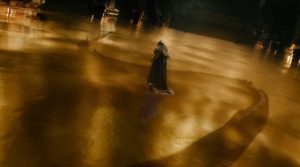 Deep in the Lonely Mountain, Thorin has been consumed by dragon sickness and covets treasure rather than peace, going back on his word to help the Lake-town folk. Bilbo has grown a true friendship with the newly-crowned King and so decides to withhold the Arkenstone from his grasp, hiding it from Thorin and eventually giving it away to Bard as a bargaining chip. I really like Bilbo’s conflict as he struggles to help his friend, and the scene with Bilbo and Thorin facing off as the Dwarves pass between them, ready for war, is great. While the film goes on to use slow motion far too frequently in the second half, I love the use of it during Thorin’s spat with Bilbo because of how it makes him sound like Smaug as a callback to Bilbo’s fantastic conversation with the dragon in the previous film. Bilbo also has a satisfying conversation with Bofur who tells the Hobbit to leave, making an interesting counterpoint to when he asked Bilbo to stay with the company when they were at the Misty Mountains in the first film. While the grand battle to come is a major disappointment, the film’s saving grace are the few small character moments sprinkled in.
Deep in the Lonely Mountain, Thorin has been consumed by dragon sickness and covets treasure rather than peace, going back on his word to help the Lake-town folk. Bilbo has grown a true friendship with the newly-crowned King and so decides to withhold the Arkenstone from his grasp, hiding it from Thorin and eventually giving it away to Bard as a bargaining chip. I really like Bilbo’s conflict as he struggles to help his friend, and the scene with Bilbo and Thorin facing off as the Dwarves pass between them, ready for war, is great. While the film goes on to use slow motion far too frequently in the second half, I love the use of it during Thorin’s spat with Bilbo because of how it makes him sound like Smaug as a callback to Bilbo’s fantastic conversation with the dragon in the previous film. Bilbo also has a satisfying conversation with Bofur who tells the Hobbit to leave, making an interesting counterpoint to when he asked Bilbo to stay with the company when they were at the Misty Mountains in the first film. While the grand battle to come is a major disappointment, the film’s saving grace are the few small character moments sprinkled in.
Thorin eventually snaps out of his greedy stupor in an incredibly disappointing way. While walking on a floor of solid gold, we get a montage of him hallucinating that he’s being literally swallowed by the precious metal while past dialogue echoes throughout the hall, calling him out on his selfish actions, before he eventually throws down his crown. I can see what they were going for but the imagery of the sequence is laughably unsubtle and unearned. I think it’s a huge missed opportunity to not have Bilbo be the one to save Thorin’s soul. We’re always hearing of the kindness and happy nature of Hobbits and it would have been fantastic for this have an impact on Thorin. Gandalf selected Bilbo because he gave him courage, and now he can give that same trait to Thorin. Bilbo was chosen for the adventure by the Dwarves to be a burglar but instead became the beating heart of the company. In helping his friend and saving Thorin through one last heart-to-heart, Bilbo would be responsible for the turning of the battle and the saving of Middle Earth. All because of the homely innocent heart of a little Hobbit from Bag End. What a perfect encapsulation of Bilbo’s journey and the message of the trilogy.
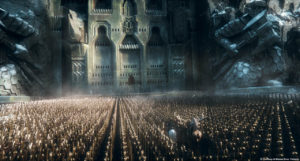 Once the armies are in place – including a CGI Billy Connelly as Dain Ironfoot, leading an army of Dwarves – the titular battle commences. It’s a battle that needs to deliver. With a final film making a mountain out of a paragraph, a war epic out of the short description of a battle in a children’s book, the battle needs to be good enough to justify its laboured creation. But it doesn’t. It tries its best to be The Lord of the Rings but the battle pales in comparison to all of the major conflicts from that trilogy. There are some good moments but mostly it’s a mess with no clear progression in the battle. Just CGI characters fighting each other. The film might as well be animated because so much of the battle is just an overload of visual effects. Despite the grand scale and inclusion of fantasy creatures, the battles of The Lord of the Rings felt visceral and tangible. But the Battle of the Five Armies doesn’t feel real at all.
Once the armies are in place – including a CGI Billy Connelly as Dain Ironfoot, leading an army of Dwarves – the titular battle commences. It’s a battle that needs to deliver. With a final film making a mountain out of a paragraph, a war epic out of the short description of a battle in a children’s book, the battle needs to be good enough to justify its laboured creation. But it doesn’t. It tries its best to be The Lord of the Rings but the battle pales in comparison to all of the major conflicts from that trilogy. There are some good moments but mostly it’s a mess with no clear progression in the battle. Just CGI characters fighting each other. The film might as well be animated because so much of the battle is just an overload of visual effects. Despite the grand scale and inclusion of fantasy creatures, the battles of The Lord of the Rings felt visceral and tangible. But the Battle of the Five Armies doesn’t feel real at all.
If you’ve made an adaptation of the beloved children’s novel The Hobbit and it gets rated a 15 by the BBFC then you know something has gone drastically wrong. As always, I watched the extended edition of the film and it is indeed rated a 15 (R in the US) and the level of violence and blood betrays Tolkien’s original work. The adaptations of the much darker and more violent Lord of the Rings series were rated PG or 12 and so for the much lighter, kid-orientated Hobbit films to get a 15 is preposterous. Jackson revels and indulges in the violence and it’s just so unnecessary. The war chariot sequence is a fun action set piece in the middle of the battle but is ruined by the numerous bloody decapitations and the ripping open of Warg bellies. Don’t get me wrong, I love a bit of the old ultra-violence in my movies, but it just doesn’t belong in The Hobbit and reveling in such things betrays the anti-war themes of Tolkien’s tale.
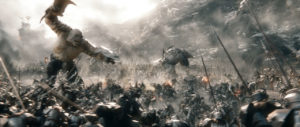 That sense of fun and adventure from the book was the best part of the first two films (when it was there) but now it’s gone and replaced with ninety minutes of grim war, which was simply a paragraph in the novel. The film does a decent job of portraying the absolute pointlessness of this battle, with characters making choices based on greed. Well, until Sauron’s forces appear and it turns into a war to save Middle Earth. The film tries so desperately hard to be another instalment of The Lord of the Rings that what made The Hobbit special is lost, and the magic of the earlier LotR films remain unmatched.
That sense of fun and adventure from the book was the best part of the first two films (when it was there) but now it’s gone and replaced with ninety minutes of grim war, which was simply a paragraph in the novel. The film does a decent job of portraying the absolute pointlessness of this battle, with characters making choices based on greed. Well, until Sauron’s forces appear and it turns into a war to save Middle Earth. The film tries so desperately hard to be another instalment of The Lord of the Rings that what made The Hobbit special is lost, and the magic of the earlier LotR films remain unmatched.
What little humour remains in the film clashes with the darkened tone and falls completely flat. These gags usually come in the form of ‘funny kills’ where Orcs or Trolls are dispatched in brutal but comedic ways. The character of Alfrid is the personification of this failed humour, becoming an embarrassing over-the-top pantomime character, complete with a scene where he dresses in drag. There are so many comparisons one can make between The Hobbit trilogy and the Star Wars prequels, with Alfrid being the trilogy’s version of Jar Jar Binks. His death scene might be the worst moment of the film series. A CGI Gandalf is fighting a CGI Troll on a green screen background and Alfrid, dressed as a woman and hiding in a trebuchet, accidently fires himself straight into the Troll’s mouth, with them both dying from suffocation.
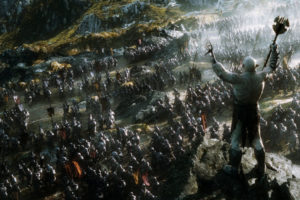 Whereas the previous films in the trilogy had scenes cut from the theatrical versions simply for runtime concerns or pacing problems, The Battle of the Five Armies seemingly had 20-minutes of content cut because the scenes were just plain bad. The aforementioned Alfrid death scene is added back into the extended edition, as are multiple moments of brutal violence and more ‘funny kills’ by the Dwarves. The scenes are often loaded with distracting CGI or are just plain boring, like the extended pre-battle sequence. The story and battle and incredibly dragged out. Two out of three of the films in the trilogy have better theatrical versions than extended, whereas the much longer editions of The Lord of the Rings films (The Return of the King is a whopping 263-minutes long) are superior to their theatrical counterparts.
Whereas the previous films in the trilogy had scenes cut from the theatrical versions simply for runtime concerns or pacing problems, The Battle of the Five Armies seemingly had 20-minutes of content cut because the scenes were just plain bad. The aforementioned Alfrid death scene is added back into the extended edition, as are multiple moments of brutal violence and more ‘funny kills’ by the Dwarves. The scenes are often loaded with distracting CGI or are just plain boring, like the extended pre-battle sequence. The story and battle and incredibly dragged out. Two out of three of the films in the trilogy have better theatrical versions than extended, whereas the much longer editions of The Lord of the Rings films (The Return of the King is a whopping 263-minutes long) are superior to their theatrical counterparts.
Despite being the shortest film of the trilogy, The Battle of the Five Armies feels like the longest. After an hour of hacking and slashing, we finally reach the conclusion of the battle at the frozen lake on Ravenhill. It’s no surprise that this section of the film also drags, although some of the fights are admittedly quite cool. Less so Bolg and Legolas’ duel which ends with the Orc’s death, but Thorin and Azog’s final encounter is a fun scene, particularly the image of Azog under the ice. At this point in the film, all emotional investment had ceased and so Fili and Kili’s deaths didn’t hit me at all, even though I began the trilogy loving the Dwarves. Thorin’s death is more successful, mainly because of Richard Armitage and Martin Freeman’s performances, and I enjoy their final scene together. Thorin passes with his friend Bilbo holding him, saying that if more people valued home rather than wealth then the world would be a much happier place. While Bilbo did play a role in Thorin’s turn away from greed, I can’t help feeling that their final moment would work much better if Bilbo had been the only character to save Thorin’s soul.
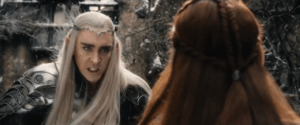 While Bilbo mourns Thorin, Tauriel grieves for Kili. The Dwarf/Elf romance subplot is a complete failure and clearly an afterthought by the writers. There’s no chemistry there and they spend so little time together that their relationship is totally unbelievable. Tauriel’s conversation about love contains some atrocious dialogue and yet somehow manages to warm Thranduil’s cold heart. After the battle, the Elven King sends Legolas on a quest to find Strider, but why? Thranduil is an isolationist; he cares not for the outside world. So why does he know about Aragorn or care about him being the heir to the throne of Gondor? It’s purely fan service and would make more sense coming from Gandalf. And what happens to Thranduil after the battle? Does he give up trying to get the white gems he sought? You know, the ones he rode into war for. I don’t see the newly crowned King Dain giving them away.
While Bilbo mourns Thorin, Tauriel grieves for Kili. The Dwarf/Elf romance subplot is a complete failure and clearly an afterthought by the writers. There’s no chemistry there and they spend so little time together that their relationship is totally unbelievable. Tauriel’s conversation about love contains some atrocious dialogue and yet somehow manages to warm Thranduil’s cold heart. After the battle, the Elven King sends Legolas on a quest to find Strider, but why? Thranduil is an isolationist; he cares not for the outside world. So why does he know about Aragorn or care about him being the heir to the throne of Gondor? It’s purely fan service and would make more sense coming from Gandalf. And what happens to Thranduil after the battle? Does he give up trying to get the white gems he sought? You know, the ones he rode into war for. I don’t see the newly crowned King Dain giving them away.
After almost nine hours of film, the end of the trilogy feels a little rushed. It’s as if Jackson didn’t want the same criticism leveled at him that the elongated multiple endings of Return of the King received, but I think he ends up going too far in the opposite direction. There are several aspects I wish we got more information on, such as Dain – a character we barely know – being named King, the remaining tension between the Dwarves and the Elves, and what happens with Bard and the former residents of Lake-town. We do get a satisfying goodbye scene between Bilbo and the Dwarves but his journey home (the ‘back again’ part of ‘There and Back Again’) is glossed over. I would have liked to have seen him dig up the Troll’s treasure chest but once you’re back in the Shire it’s hard to complain about anything. Returning there after over 2-and-a-half hours of death and destruction feels like a warm and cozy embrace. While I shy away from going too far into Lord of the Rings territory, it’s hard not to smile at the very end when Gandalf returns and the familiar dialogue from Fellowship begins to play as the credits roll.
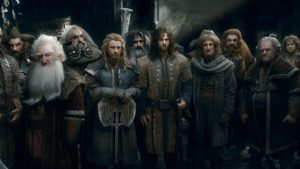 Plainly, I dislike an awful lot of The Battle of the Five Armies. There are some good moments and sequences but overall, it’s a distended and needlessly dour mess. The film has such a different tone and flavour than An Unexpected Journey – my favourite of the three – and it’s crazy that both films belong to the same trilogy, with The Desolation of Smaug acting as a transitional instalment that lies in the middle (but closer to An Unexpected Journey) in terms of quality. Battle is the instalment that fully becomes a lacklustre Lord of the Rings prequel first and an adaptation of The Hobbit second. It doesn’t eliminate the good will I have towards the elements of the first two films I enjoy but it’s a very disappointing movie and end of the trilogy. It leaves a bad taste in the mouth and knowing what is to come from the final instalment is making me think twice about whether I’ll ever rewatch The Hobbit trilogy again.
Plainly, I dislike an awful lot of The Battle of the Five Armies. There are some good moments and sequences but overall, it’s a distended and needlessly dour mess. The film has such a different tone and flavour than An Unexpected Journey – my favourite of the three – and it’s crazy that both films belong to the same trilogy, with The Desolation of Smaug acting as a transitional instalment that lies in the middle (but closer to An Unexpected Journey) in terms of quality. Battle is the instalment that fully becomes a lacklustre Lord of the Rings prequel first and an adaptation of The Hobbit second. It doesn’t eliminate the good will I have towards the elements of the first two films I enjoy but it’s a very disappointing movie and end of the trilogy. It leaves a bad taste in the mouth and knowing what is to come from the final instalment is making me think twice about whether I’ll ever rewatch The Hobbit trilogy again.
What are your thoughts on The Battle of the Five Armies? What’s your ranking of all six Middle Earth films? Let me know in the comments and be sure to geek out with me about TV, movies and video-games on Twitter @kylebrrtt.




